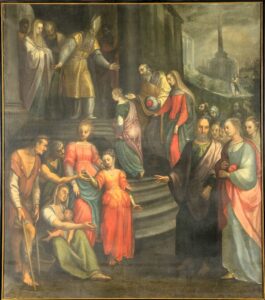Master Adam van Noort: Presentation of Mary
At the museum Maagdenhuis: proceed to the (former) chapel, if accessible.
Carel Van Mander again, in 1604, about Adam van Noort “… who is also a skillful figure painter”.
The Maagdenhuis has been Antwerp’s orphanage for girls for more than 300 years (1552 to 1882). It is now a museum that holds a compact collection of valuable paintings, largely on subjects about its role in the city’s social history. Here we meet Rubens’ s second teacher, Adam van Noort. One of his paintings hangs in the former chapel, still in its original place; it’s called the ‘Presentation of the Blessed Virgin Mary’.
To clarify the theme of the painting: according to an old legend Mary’s elderly parents, Joachim and Anna, took her to the temple in Jerusalem at a very young age. They wanted to prepare their daughter for a life consecrated to God. This story cannot be found in the Bible, but its part of the apocryphal writings. However, the Catholic Church and Orthodoxy still celebrate this event on November 21. It is intended to inspire girls not to restrict themselves to knowledge and skills; they should also acquire religious virtue.
Adam van Noort (1562-1641) learned the craft from his father Lambert (Amersfoort, 1521 – Antwerp 1571). Adam ran a studio at Hofstraat 22 in Antwerp. He counted Rubens and Van Balen among his pupils, but most of all, he was Jordaens’s main teacher. This Jacques Jordaens married his daughter Catharina on May 15, 1616. Jacques repeatedly portrayed his – extended – family as we have seen; through comparison with other portraits, also the central figure in the painting ‘The King Drinks (or Twelfth Night King)’ can be identified as his father-in-law.
Let us focus on the painting again. Layers of varnish have darkened the original fresh colours. A restoration would possibly bring them out of the shadows again. The composition with figures in the foreground and figures in the background is typical of the late 16th century. The central theme is in the middle and in the grey background, we catch a glimpse of Joachim and Anna at the Golden Gate in Jerusalem. A painting like this still tells several chapters from the same story; later, in the Baroque period, that will shift to a single cover story.
The characters display expressive hand gestures towards each other, but hardly move us as spectators. We don’t feel emotionally involved, even though we are sympathetic towards the logic that this edifying, educational work is in its place here, in an orphanage.
Proceed to the Vander Meere room (if accessible)

